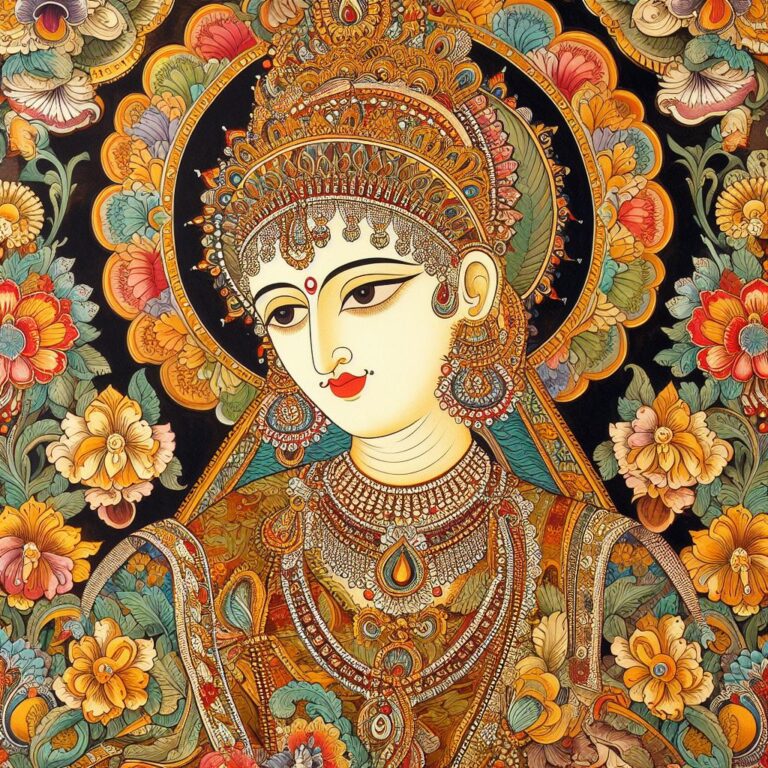Patachitra, a traditional folk art form originating from the eastern state of Odisha in India, is a vibrant and intricate art style that has captivated art enthusiasts and cultural connoisseurs for centuries.
The word ‘Patachitra’ is derived from the Sanskrit words ‘Pata,’ meaning cloth, and ‘Chitra,’ meaning picture.
This unique form of art involves the creation of intricate, colorful, and narrative paintings on cloth, depicting various mythological, religious, and folk themes.
Patachitra paintings are not just artistic expressions; they are windows into the rich cultural heritage and mythology of the region.
Table of Contents
Historical Significance
Patachitra painting has a rich history dating back over a thousand years. It finds its roots in the Jagannath cult, a major religious tradition in Odisha.
The paintings were initially created as illustrations for religious texts, depicting stories of gods, goddesses, and mythological events.
Over time, Patachitra artists started incorporating themes from epics like Ramayana and Mahabharata, as well as folk tales, village scenes, and social issues, making the art form more diverse and inclusive.
Techniques and Materials
The creation of a Patachitra painting is a labor-intensive and meticulous process. Artists start by preparing a canvas made of cloth, typically using materials like old sarees or cotton fabric.
The canvas is coated with a mixture of chalk and gum to create a smooth surface for painting.
The artists then use natural pigments derived from minerals, stones, and plants to create vivid and enduring colors.
Brushes made from animal hair or bamboo sticks are used to draw fine lines and intricate details.
Themes and Motifs
Patachitra paintings are characterized by their distinctive style, which includes bold outlines, vibrant colors, and intricate detailing.
The themes of these paintings often revolve around Hindu deities like Jagannath, Krishna, and Durga, depicting their various forms and stories.
Besides religious themes, Patachitra artists also depict scenes from rural life, folk tales, and nature.
The paintings are adorned with intricate motifs such as flowers, animals, birds, and geometric patterns, adding to their visual appeal.
Revival and Modern Influences
In recent years, there has been a renewed interest in traditional art forms like Patachitra painting. Artisans and organizations are working tirelessly to preserve and promote this ancient craft.
Modern artists are also experimenting with Patachitra, incorporating contemporary themes and techniques, thus giving this traditional art form a fresh perspective and wider recognition.
Patachitra painting stands as a testament to the artistic brilliance and cultural richness of Odisha.
Its timeless appeal, coupled with the dedication of skilled artisans, ensures that this traditional art form continues to thrive and evolve.
As we celebrate the heritage and legacy of Patachitra painting, it is essential to recognize the importance of preserving such art forms, ensuring that they continue to inspire generations to come.
FAQs about Patachitra Painting
- What is Patachitra Painting?
- Patachitra is a traditional folk art form from the eastern regions of India, particularly Odisha and West Bengal. It involves intricate, colorful paintings on cloth, depicting mythological and religious themes.
- What materials are used in Patachitra Painting?
- Patachitra artists typically use natural materials such as handmade paper, cloth, natural colors derived from minerals and vegetables, and brushes made from animal hair.
- What are the themes commonly depicted in Patachitra Paintings?
- Patachitra paintings often portray scenes from Hindu mythology, folklore, and religious stories. Common themes include depictions of gods and goddesses, episodes from the Mahabharata and Ramayana, and scenes from daily life.
- How is Patachitra different from other Indian art forms?
- Patachitra is distinct due to its use of vibrant colors, intricate detailing, and the characteristic use of bold lines. It is often characterized by its narrative style, telling stories through sequential panels in a scroll-like format.
- Who are the traditional practitioners of Patachitra Painting?
- Patachitra is traditionally practiced by skilled artisans and communities, often passed down through generations within families. The artists, known as “chitrakars,” are integral to the preservation and continuation of this art form.
- Is Patachitra limited to religious themes, or are there other subjects depicted?
- While Patachitra commonly depicts religious and mythological themes, artists also explore contemporary subjects, social issues, and aspects of daily life. This flexibility allows for a dynamic evolution of the art form.
- How is Patachitra traditionally created?
- Patachitra is often created using a sequential process. The outline is drawn first, followed by the application of colors. The artists use a stylized technique that involves intricate detailing and patterns, creating a visually striking and narrative artwork.
- Is Patachitra only limited to paintings, or are there other forms of expression?
- In addition to traditional paintings, Patachitra artists may create diverse art forms, including scrolls, masks, and even handcrafted items like pots and textiles. The art form extends beyond paintings to encompass various forms of artistic expression.
- How has modernization affected Patachitra Painting?
- While traditional techniques are still prevalent, some artists have embraced modern tools and materials to adapt to contemporary demands. However, efforts are being made to balance innovation with the preservation of the traditional essence of Patachitra.
- Can Patachitra Paintings be purchased, and where can one find authentic pieces?
- Yes, Patachitra paintings are available for purchase, both in traditional markets in regions where the art form originates and through online platforms. It is essential to ensure the authenticity and source of the artwork when making a purchase.


0 Comments